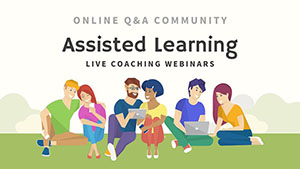
Learn PHP Programming for Absolute Beginners
$99 Value

MySQL Database Development for Beginners
$99 Value

PHP and MySQL for Beginners
$99 Value

An Introduction to PHP and MySQL
FREE

Redis and PHP
$50 Value

Joomla for Beginners
$49 Value

Live Coaching Webinars and Online Q&A Community
Assisted Learning

Learn PHP Programming for Absolute Beginners
EDUmobile Academy develops high quality video training courses around topics in mobile development including iPhone, Android, Windows Phone, Java, Responsive Web Design and other emerging technologies.
Every course is created by an expert developer AND a trained mentor in the area of expertise.
Each course undergoes a rigorous planning, review and an internal quality check phase - to ensure that the teaching is of highest standards available online.
EDUmobile Academy was founded in 2008 when smart phones were just emerging into the market. Founder Vishal Lamba is experienced in multiple areas of digital design, mobile development and design, web technologies and digital marketing. He has a mathematics and computer science degree from Lawrence University, USA. Vishal works closely with content creators and teachers to ensure that every course released meets the internal rigorous quality standards.All course creators and trainers are currently based in the USA. Support for each course on Udemy is provided with quick turn around by a small team of developers and trainers.

MySQL Database Development for Beginners
EDUmobile Academy develops high quality video training courses around topics in mobile development including iPhone, Android, Windows Phone, Java, Responsive Web Design and other emerging technologies.
Every course is created by an expert developer AND a trained mentor in the area of expertise.
Each course undergoes a rigorous planning, review and an internal quality check phase - to ensure that the teaching is of highest standards available online.
EDUmobile Academy was founded in 2008 when smart phones were just emerging into the market. Founder Vishal Lamba is experienced in multiple areas of digital design, mobile development and design, web technologies and digital marketing. He has a mathematics and computer science degree from Lawrence University, USA. Vishal works closely with content creators and teachers to ensure that every course released meets the internal rigorous quality standards.All course creators and trainers are currently based in the USA. Support for each course on Udemy is provided with quick turn around by a small team of developers and trainers.

PHP and MySQL for Beginners
Instructor: LearnToProgram, Inc.

An Introduction to PHP and MySQL
Instructor: University of Michigan

Redis and PHP
Instructor: SkillBakery Studios
- You will be able to work with Redis using PHP Client PRedis
- You must have programming experience in PHP
- Installing Redis on Windows
- Installing Redis on Linux instance using Amazon Web Services
- Working with Predis - Redis Client
- Learning the basics of Redis
- Exploring Sets
- Exploring Sorted Sets
- Exploring Lists
- Exploring Hashes
- Integrating Redis with PHP Forms
- Web Developers with experience in PHP

Joomla for Beginners
Instructor: LearnToProgram, Inc.



